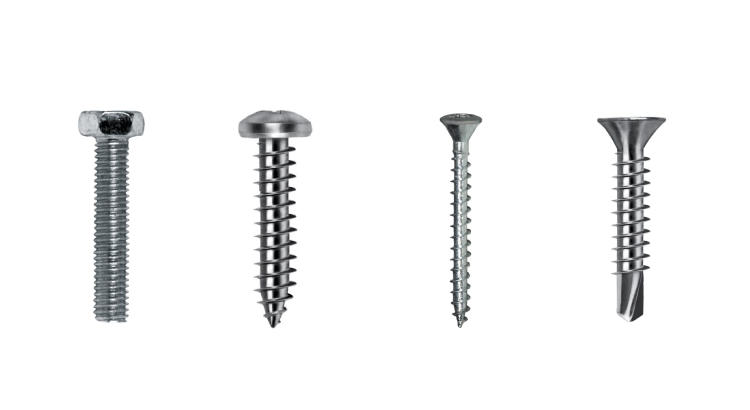Screw points are a crucial aspect of screw design that can greatly improve the installation process. The screw point is located at the end of the screw and serves to enhance ergonomics during installation. Depending on the screw point’s design, it can perform a range of functions, including drilling holes, piercing through materials, extruding, and cleaning welding residues. By using the appropriate screw point for a specific application, professionals can ensure a more efficient and effective installation process.
Below we go through some of the most common screw points:
Type C Point Screws
Type C point screws are a common type of self-tapping screw that feature a sharp, pointed end shaped like the letter “C”. One of the key advantages of the C point design is that it can help to locate the base hole and drill into materials with the proper amount of pressure.
During installation, the C point of the screw is driven into the material, and the edges of the point tap into the material to create threads. This tapping action helps to create a secure hold, while the sharp edge of the C point can also help to minimize the risk of the screw stripping or breaking during installation.
Type S screw points
The S point is another type of screw point commonly used in wood tapping screws. Unlike the C point, which has a sharp pointed end shaped like a “C”, the S point screw has a sharper and more defined pointed end shaped like an “S”. The design of the S point provides improved piercing performance, making it easier to penetrate wood and other similar materials.
The S point screw can create a pilot hole while it is being installed, which makes it easier to drive the screw into the wood without splitting it. This is particularly useful in wood construction, where the screw’s ability to penetrate the wood without damaging it is essential.
Progressive point screws
The progressive point is a specialized screw point used in self-tapping and self-threading screws. The point is designed to help the screwing force not increase abruptly at the beginning of the installation process and helps prevent the screw from jumping or slipping out of position during installation, improving the accuracy of the installation process.
During installation, the progressive point gradually taps threads into the material, reducing the amount of force required to drive the screw into the material. This can be particularly useful in applications where the screw must be installed quickly or where the material being worked with is fragile and prone to damage.
Conical point screws
The conical point is a type of screw point designed to improve aiming during installation, without ending in a sharp point that could damage or puncture sensitive parts. The conical point is a rounded point that tapers gradually to a flat end, providing a smooth and precise surface for installation.
The design of the conical point can be particularly useful in applications where the screw must be installed close to sensitive or fragile materials, such as in electronics, automotive, or medical devices. The conical point helps to minimize the risk of damage or puncture to these materials, while still providing a secure hold.
Drill point screws
The drill point is a type of screw point that can drill a hole in different materials. This type of screw point is commonly used in applications where a pilot hole is required for the screw to be installed, such as in metalworking, woodworking, and construction.
The drill point is designed to penetrate the material and create a hole as the screw is being installed. This can be particularly useful in materials such as metal, which require a pilot hole for the screw to be installed properly. The drill point design also helps to prevent the material from splitting or cracking during installation, providing a more secure hold.


